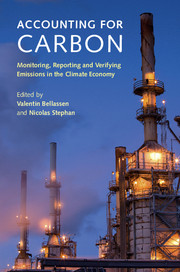Book contents
- Frontmatter
- Contents
- List of figures and map
- List of tables
- List of boxes
- Notes on contributors
- Acknowledgements
- 1 Introduction: key notions and trade-offs involved in MRVing emissions
- Part I MRV of territorial/jurisdictional emissions
- 2 Trendsetter for territorial schemes: national GHG inventories under the UNFCCC
- 3 Variant 1: region/city geographical inventories
- 4 Variant 2: sectoral MRV at the jurisdictional level–forestry (REDD+) in the VCS and the UNFCCC
- Part II MRV of industrial sites and entities
- Part III MRV at offset project scale
- Index
- References
2 - Trendsetter for territorial schemes: national GHG inventories under the UNFCCC
from Part I - MRV of territorial/jurisdictional emissions
Published online by Cambridge University Press: 05 March 2015
- Frontmatter
- Contents
- List of figures and map
- List of tables
- List of boxes
- Notes on contributors
- Acknowledgements
- 1 Introduction: key notions and trade-offs involved in MRVing emissions
- Part I MRV of territorial/jurisdictional emissions
- 2 Trendsetter for territorial schemes: national GHG inventories under the UNFCCC
- 3 Variant 1: region/city geographical inventories
- 4 Variant 2: sectoral MRV at the jurisdictional level–forestry (REDD+) in the VCS and the UNFCCC
- Part II MRV of industrial sites and entities
- Part III MRV at offset project scale
- Index
- References
Summary
Context
The MRV of territorial/jurisdictional emissions, especially in the frame of the United Nations Framework Convention on Climate Change (UNFCCC) and its Kyoto Protocol, is the longest-lasting implementation of monitoring, reporting and verifying of GHG emissions. The concept of MRV was developed progressively in the frame of the UNFCCC and Kyoto Protocol through negotiation and scientific inputs from the Intergovernmental Panel on Climate Change (IPCC). The UNFCCC created an actual dynamic in this field, bringing together scientists, politicians, technicians and economists to build international consensus on how to track GHG emissions and their trends, in order to demonstrate compliance with emissions reduction targets. This MRV process has been applied for several years on a national scale the related experience and feedback are also useful for application to other scales.
The United Nations Framework Convention on Climate Change (UNFCCC) was adopted at the “Rio Earth Summit” in 1992. Initially signed by 154 nations, it has 195 parties to date (end of 2014). The ultimate objective of this Convention is “to stabilise greenhouse gas concentrations in the atmosphere at a level that would prevent dangerous anthropogenic interference with the climate system” (Article 2 of the Convention). The scope of this Convention was to monitor all greenhouse gases not controlled by the Montreal Protocol. The countries which signed the Convention (so-called Parties) meet annually to assess progress in combating climate change and possible changes in the framework of the Convention. This is called the Conferences of the Parties (COP). Thus, common rules on MRV, among other topics, have been decided at the COPs. In particular, the 9th COP in 2003 decided that Parties have to use the Intergovernmental Panel on Climate Change (IPCC) guidelines as a reference of good practice for the national GHG emissions inventories.
The Convention divides countries into two sets of Parties. Annex I Parties are the industrialized countries which were members of the Organisation for Economic Co-operation and Development (OECD) in 1992 as well as countries with Economies In Transition (EITs), i.e., the former communist bloc.
- Type
- Chapter
- Information
- Accounting for CarbonMonitoring, Reporting and Verifying Emissions in the Climate Economy, pp. 21 - 71Publisher: Cambridge University PressPrint publication year: 2015
References
- 1
- Cited by



